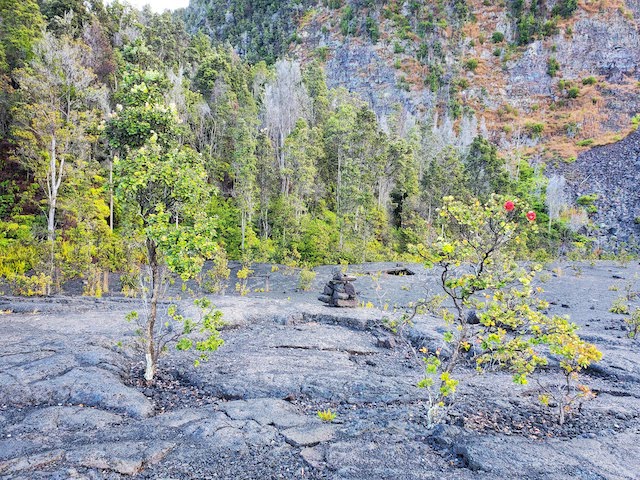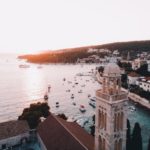On Becoming Intimate With A Volcano

I was born on the island of Oahu in 1982 to two military parents. We left in 1984 when my parents were transferred to New Jersey. It would be 13 years before I returned to the island with my mother one summer. We visited Maui and Oahu for several days each, but the proximity of the islands and ease of inter-island travel enabled us to take a day trip to the Big Island to visit Hawaii Volcanoes National Park. The park is home to Mauna Loa and Kilauea, two of the world’s most active volcanoes, described as such even in 1916.
It was during this trip that I learned of the Hawaiian Volcano goddess, Pele (Pelehonuamea, “the one who devours”). Said to reside in Kilauea’s Halema’uma’u Crater, Pele is known to be quick-tempered, powerful, and strong-willed. As written in the foreword of Selections from Hawaiian Legends of Volcanoes “…her powerful deeds are a metaphor and symbol of feminine strength.”

In 1997 and 2007 (the subsequent trip I took) it was possible to walk to the edge of Halema’uma’u Crater and pay homage to the goddess by way of laying a flower lei or building an offering out of the small pieces of lava rock lying around. The Volcano was erupting during those first two trips and the trek to see lava was a shade-less six miles over the rocky remnants of past eruptions. Still, steam from where the lava entered the ocean could be seen from afar.
I can’t help but feel like there is a connection between Kilauea’s volcanic activity and my island arrivals and departures.
I can’t help but feel like there is a connection between Kilauea’s volcanic activity and my island arrivals and departures. I left Hawaii in 1984 to move to New Jersey. The Pu’u O’o eruption, the longest and most voluminous outpouring of Kilauea’s East Rift Zone in more than 500 years, began in January 1983 and continued for 35 years. In January 2018, I found out I was going to be stationed in Hawaii. In April 2018, increased pressure under Pu’u O’o resulted in collapse of the crater floor and magma migration to Kilauea’s lower East Rift Zone. This became the largest lower East Rift Zone eruption and caldera collapse in at least 200 years.
After nearly 36 years of activity, the lava flow stopped in December 2018, five months after I arrived on Oahu. My husband, stepson, and I visited the Volcano in 2019. Although there was no active eruption at the time, the steam vents were a reminder that the Volcano is a living thing. She started erupting again on December 20, 2020. This coincided with me finding out that we would be relocating to Maryland the following summer.

- In the caldera, ohi’a lehua and offerings.
I felt called. We visited the Volcano again in January 2021, this time with our 7-month-old son as well. We stayed on the crater rim at the Kilaeua Military Camp. The night we arrived, the clouds above had a reddish hue from the lava lake below. Pele’s presence was unmistakable.
After nearly 36 years of activity, the lava flow stopped in December 2018, five months after I arrived on Oahu
The following morning, we went to the Kilauea lookout. An information board showed comparisons of how the landscape had changed so dramatically over the course of a few short months in 2018. Far below the edge was Halema’uma’u Crater, no longer even visible from our vantage point. We could see the smoke coming from the lava lake down below. We walked along the trail around the crater rim, staring in awe at the caldera. It was so hard to believe you used to be able to walk right up to the crater.
That evening we saw “The Glow.” Once again we headed toward the lookout, only to find ourselves in a long line of cars to get into the parking lot that was empty earlier in the day.

- The Glow.
Rather than wait, we parked the car at our lodging and took the trail directly across, walking nearly a mile toward the lookout. We found a quiet spot where we were alone and had a perfect view of the glow, reflected by the billowing smoke. It was amazing to be there with this vivacious piece of earth. Just remarkable.
Our last morning there, I got up early and went to the trail head leading to the caldera floor. As I made my way down, I was the only person in the lush rain forest through which the trail passed. When I arrived at the bottom, there was no rope where there had been the previous time I was there, and the landscape was vast and other-worldly. I could see the smoke coming from Halema’uma’u Crater far away. If I so desired, I could just walk across the caldera floor to get there. When the wind blew from the direction of the crater, it was warm at times.
Although there was no active eruption at the time, the steam vents were a reminder that the Volcano is a living thing.
There were Ohia bushes everywhere, some with the vibrant red lehua blossoms. Often associated with Pele, the Ohi’a Lehua takes on as many forms and exhibits as much tenacity as the goddess herself. The plant can be found growing in both dry and wet environments, from sea level to great heights. It can be a shrub, a massive tree, or even an epiphyte living on other trees. The O’hia Lehua is one of the first plants to regrow in the desolate land covered in lava, perhaps another metaphor for feminine fortitude and resilience.
All around there were offerings to Pele made from the loose lava rock. Of course, I made my offering, as I had at every visit to the Volcano before that. I ran my fingers along the ground, hardened lava from eruptions that took place in the seventies, noticing the different textures between it and the rocks with which I made my offering.
I sat for several moments, allowing the realization that I was in a place of such energy, such power, to sink in. This experience was definitely worth getting up extra early to make the trip down. Especially to be alone with Pele.
This summer we will relocate to Maryland, but the Volcano remains a part of me. One day we will return to the Hawaiian Islands to retire in paradise. I look forward to seeing what phenomena Pele brings.
Photo credits for Becoming Intimate With A Volcano by Jean Rubanick.









Enjoyed reading about your experiences, Jean! “Vivacious piece of earth” – loved that sentence.